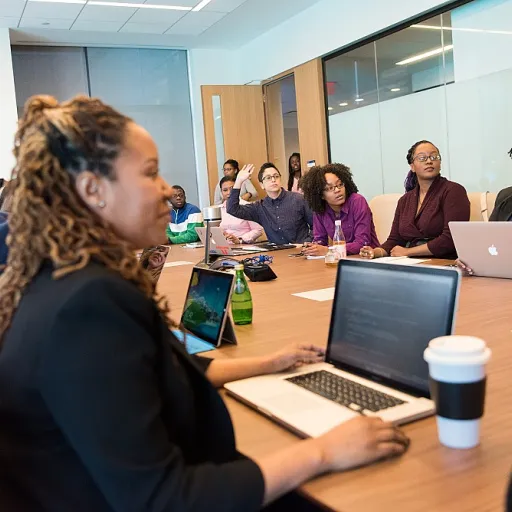
Defining Lateral Transfers
Exploring the Dynamics of Lateral Transfers
In the realm of succession planning, the concept of a lateral transfer often emerges as a strategic tool for enhancing internal mobility and employee development. But what exactly is a lateral transfer? At its core, a lateral transfer involves moving an employee from one role to another within the same organization, typically at a similar level of responsibility and pay grade. Unlike promotions, which usually involve a rise in rank or pay, lateral transfers focus on broadening an employee's experience and skill set.
Lateral transfers can be a vital part of a company's recruitment strategies, offering employees the chance to explore different roles and teams without leaving the organization. This type of job transfer can help employees develop new skills, gain diverse experiences, and prepare for future opportunities. By facilitating a lateral move, companies can ensure a smooth transition for employees seeking to enhance their career advancement without necessarily climbing the traditional corporate ladder.
While lateral transfers might not immediately offer upward mobility, they provide a free and flexible way for employees to request lateral moves that align with their career goals. This approach not only benefits employees but also strengthens the organization by fostering a culture of continuous learning and adaptability. As we delve deeper into the benefits and challenges of lateral transfers, it's essential to understand their role in creating a robust succession planning framework.
For more insights into how lateral transfers differ from other employment changes, you can read about the differences between termination and resignation in succession planning.
Benefits of Lateral Transfers
Advantages of Intra-Organizational Moves
Lateral transfers, often seen as complementary to promotions, offer distinct benefits that contribute to both employee satisfaction and organizational health. These transfers involve an employee moving to a different role at the same level, allowing them to broaden their skills and gain diverse experience, critical for robust career development. Consider the benefits lateral transfers bring to the table:- Skill Diversification: Employees get exposed to new responsibilities and challenges, fostering an environment for skill enhancement and broadening professional capabilities. By embracing new roles, they acquire diverse experiences essential for their career advancement.
- Increased Engagement and Satisfaction: The opportunity for a lateral move often ignites excitement among employees, as it allows for growth without the pressure of immediate upward mobility. This engagement translates to increased job satisfaction and, consequently, boosts morale within teams.
- Flexible Workforce Management: Employers enjoy the versatility of a workforce that can seamlessly transition between departments or roles. This flexibility aids in smooth transitions, ensuring that employee moves within the company are aligned with strategic objectives.
- Cost-effective Recruitment Strategy: Filling a role through lateral transfer can often be more economical than hiring externally. The company can save on recruitment and onboarding costs while benefiting from an employee's existing knowledge of the organization.
- Promotion of Internal Mobility: Encouraging lateral job transfers fosters a culture of internal mobility, where employees feel supported in their desire to explore new opportunities within the organization. This internal movement can eliminate stagnation and unlock future opportunities for employees.
Challenges in Implementing Lateral Transfers
Addressing the Hurdles of Internal Mobility
Implementing lateral transfers effectively involves a range of challenges that organizations must navigate. Understanding these hurdles is crucial for businesses aiming to leverage lateral moves as part of their internal mobility and employee development strategies. Firstly, communication is key. Ensuring that employees are aware of the potential career advancement opportunities that lateral transfers can offer is essential. This includes clearly articulating how such movements can enhance skills development and prepare employees for future roles. Without transparency, employees may misinterpret these moves as stagnant, rather than as an enriching career development path. Moreover, while lateral transfers offer numerous benefits, they require careful execution to ensure a smooth transition. This involves aligning the employee's skills and experience with the new position to prevent mismatches that could hinder team performance. A well-structured transition plan, that possibly includes a role-specific training period, helps employees to efficiently integrate into their new roles and continue their career progression without disruption. Another challenge is ensuring fairness and inclusivity in the process. Management must avoid biases, providing equal opportunities for all employees irrespective of their current role or tenure. A transparent request process is crucial for fostering a culture of trust and motivation among employees. This, in turn, strengthens the overall success of succession planning initiatives. Finally, integrating lateral transfers into an organization's recruitment strategies is imperative. Decision-makers should understand that lateral moves aren't just about filling gaps but are a strategic tool for long-term workforce planning. By systematically incorporating them into career development frameworks, companies are better positioned to build a versatile workforce ready for future opportunities. For further insight into the importance of internal mobility in succession planning, you can explore the insights on organizational culture inventory.Lateral Transfers vs. Promotions
Comparing Lateral Transfers and Promotions
When considering career advancement, employees often weigh the benefits of lateral transfers against traditional promotions. Both options offer unique opportunities for growth, but they serve different purposes in the context of succession planning.
Promotions typically involve moving an employee to a higher-level position, often accompanied by increased responsibilities, a new job title, and a higher pay grade. This upward mobility is a clear path for those seeking to climb the corporate ladder and take on leadership roles. Promotions are generally seen as a reward for an employee's performance and readiness to take on more significant challenges.
On the other hand, lateral transfers focus on broadening an employee's experience and skill set without necessarily changing their level within the organization. A lateral move allows employees to explore different roles within the company, enhancing their understanding of various functions and contributing to their overall development. This type of internal mobility can be particularly beneficial for employees looking to diversify their skills and prepare for future opportunities.
While promotions are often the goal for many, lateral transfers offer a strategic alternative for those who wish to gain a more comprehensive view of the organization. By moving to a different team or department, employees can build a diverse skill set that may eventually lead to higher-level roles. This approach aligns with effective succession planning, as it prepares employees for a variety of positions, ensuring a smooth transition when key roles need to be filled.
Ultimately, the choice between a lateral transfer and a promotion depends on the individual's career goals and the organization's needs. Both paths offer valuable opportunities for growth and development, contributing to a robust succession planning strategy.
Role of Lateral Transfers in Succession Planning
The Strategic Role of Lateral Transfers in Succession Planning
Lateral transfers play a pivotal role in succession planning by offering a dynamic approach to employee development and internal mobility. Unlike traditional upward mobility, lateral moves allow employees to gain diverse experience across different roles and departments, enhancing their skills and preparing them for future opportunities.
By facilitating lateral job transfers, organizations can help employees broaden their understanding of the business, which is crucial for effective succession planning. This strategy not only aids in career advancement but also ensures a smooth transition when key positions become vacant.
Moreover, lateral transfers can serve as a recruitment strategy to retain top talent. When employees see opportunities for growth and development through lateral moves, they are more likely to stay with the company, reducing the need for external recruitment. This internal mobility fosters a culture of continuous learning and adaptability, essential for long-term organizational success.
Incorporating lateral transfers into succession planning also addresses the challenge of skill gaps. By allowing employees to move positions and take on new roles, organizations can develop a versatile workforce ready to tackle various challenges. This approach not only benefits employees by expanding their career paths but also strengthens the organization's talent pool, ensuring readiness for future leadership roles.
Ultimately, the integration of lateral transfers into succession planning is a strategic move that aligns employee development with organizational goals, creating a win-win situation for both parties.
Best Practices for Successful Lateral Transfers
Best Practices for Facilitating a Successful Lateral Move
When planning for lateral transfers within an organization, implementing comprehensive strategies can significantly enhance the effectiveness of these moves. Here are some key practices to ensure a smooth transition and maximize the benefits of lateral transfers:- Align Transfer with Career Development: Aligning a lateral move with an employee’s career aspirations and skills development is crucial. This alignment helps employees view the transfer as an opportunity for career advancement and future opportunities.
- Ensure Transparent Communication: Effective communication during the process is essential. Providing clear information to employees about the purpose of the transfer, potential benefits, and expectations of the new role can help minimize uncertainty and foster enthusiasm.
- Facilitate Training and Support: A successful lateral transfer often requires providing employees with the necessary training and support to thrive in their new position. This includes offering resources for skill enhancement and access to mentoring or coaching programs.
- Embrace Internal Mobility: Promoting a culture of internal mobility within the organization encourages employees to explore diverse roles. This cultural shift can lead to increased job satisfaction and the retention of valuable talent.
- Assess Fit and Readiness: It is important to assess both the employee’s readiness for the lateral job and the fit with the new team. This involves evaluating skills, experience, and cultural fit to ensure a seamless integration into the new role.
- Leverage Technology for Efficient Process: Utilize technology and HR tools to streamline the lateral transfer process, making it more efficient. This could include automating the request lateral system or using data analytics to match employees with suitable positions.












